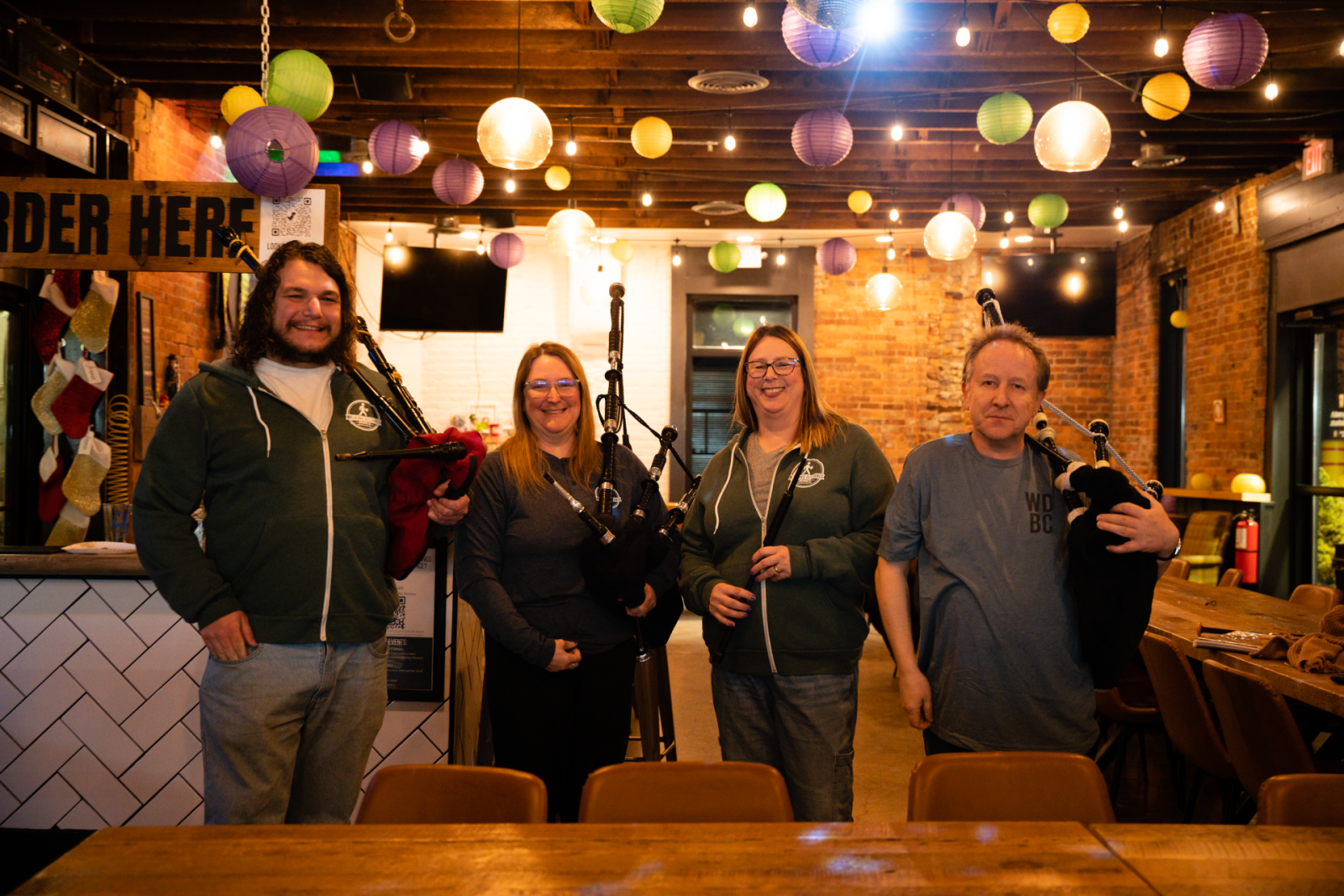Meet the only central Ohio craft brewery with a bagpipe band

And now, for something completely different.
It’s a crisp, clear Tuesday night, and gathered around a table in Marysville’s otherwise deserted Walking Distance Brewing Co. are five amateur bagpipers, rolling through tunes on their practice chanters.
A disco ball spins slowly overhead in the renovated carriage shop, its white reflections drifting like snowflakes on the ceiling. On a nearby table, Rock Em Sock Em Robots stand poised to rumble. Off to the side, a poster covered in red X’s tracks the fate of the few remaining contestants on The Bachelor.
Walking Distance is a brewery focused around community and a warm sense of whimsy. There’s an old bingo board overhead (which is actually used for bingo), vintage board games, and a few heavily upholstered chairs in a corner. Their raspberry ale is called “THBBFT”—the sound of a razzberry.
And, as you bask for a moment in that welcoming vibe, one of the pipers looks over and asks you, “So—how many embryonic pipe bands have you met?”
Exactly zero, until now.
BROUGHT TO YOU BY
Teddy Valinski, co-owner of Walking Distance, played bagpipes in high school, and, as you might expect after meeting him and hanging out in the taproom for half an hour, the origin of his passion turns out to be pretty comical.
As a five-year-old in New Jersey, watching Hillary Clinton rise to political prominence, Teddy set a goal: He wanted to be the first woman President. “The logical step was that I would have to wear dresses, but my mom didn’t want me getting bullied,” he explained. He realized playing bagpipes was also a way to wear a “skirt,” and decided that’s what he was going to do.
“It took ten years, and at that point, I realized I didn’t want to be a politician or a woman,” he recalled. “But I still wanted to play bagpipes.”
Now, Teddy works for AEP. He learned the foundations of brewing as an electrical engineering student at the University of Pittsburgh and, with the help of co-owner Doug Olsen, opened Walking Distance as a side project in October 2021.
It wasn’t long before another goal crossed his mind.
“St. Patrick’s is my favorite holiday,” he said. “I wanted to go big, because Covid had just happened. ‘I’ll play the bagpipes every hour,’ I thought.” It forced him to practice again, but something else happened as well—something completely unintended.
A handful of people were intrigued and asked him, “How’d you learn?”
“It just kind of snowballed from there,” he recalled. A week or so later, he put out a survey to Walking Distance’s followers: “If you want to learn to play bagpipes, fill this form out.”
And people did.
Three of those people, all adventurous, middle-aged women and former clarinet players, practice in the Tuesday night group regularly. Others drop in as they’re able. And they have a second leader, now, too.
Ewan Hamilton also played the bagpipes as a teenager in his native Scotland. But last year, he’d become a patron at Walking Distance, while, coincidentally, his wife had been pressuring him to play again. After a few months of consideration, he, too, joined the group and is passing on the knowledge he gained in his youth.
“[Ewan]’s been a very good leader for us,” Jennifer Dutter said. “Not that Teddy’s not, but this is a whole other level.”
Teddy estimates he was a Grade 5 bagpiper, while Ewan was a Grade 2—the highest level of amateur. “When Ewan showed up, I was better than him… for like two weeks,” Teddy said, laughing.
Ewan describes playing bagpipes as “a pseudo-physical ordeal.” There’s breath control, strength, and coordination that can’t be learned from YouTube videos. Plus, “Every little blip is spoken for.” There’s no improvisation in traditional bagpipe playing. Each tiny embellishment in the melody (and there are dozens) is dictated on the page. It’s complicated, and beginners have to take the time to break it all down into easily digestible steps.
“Nobody learns how to play the bagpipes by themselves,” Ewan admitted. “How to Learn Bagpipes in Ten Easy Steps—that doesn’t happen.”
Teddy started Walking Distance’s band with the goal of being fully up and running in two years, which is an ambitious timeline, given the complexity of the instrument and the time to learn. At almost a year in, things are going well. Amy Frank and Jennifer are awaiting delivery of new pipes from Edinburgh. Lisa Swiatek was fortunate to find a set of good used pipes and was trying them out for the first time.
So how do they rehearse, without pipes? Well, that’s what practice chanters are for. Highland bagpipes have a single volume: Just Shy of Deafening. Even a pipe chanter alone, with its reed and finger holes for making different pitches, is really loud. Practice chanters have the same holes but a different mouthpiece and reed setup, to produce a volume that’s more bearable for everyday work. Plus, it’s an affordable way to get started.
“It’s been really good for me. Even though I’m here with my good friend [Lisa], I’m making good friends,” Jennifer said. “It’s been nice to find new, fun things to do.”
So, while Walking Distance continues to turn out craft beers, the community’s “embryonic pipe band” is beginning to perform in some capacity on its home turf. Teddy’s even having the brewery’s stick-figure logo updated to hold bagpipes.
Unexpected? Maybe. But, once you visit Walking Distance, it’s not at all surprising.
Want to read more? Check out our print publication, (614) Magazine. Learn where you can find a free copy of our new March issue here!
BROUGHT TO YOU BY



